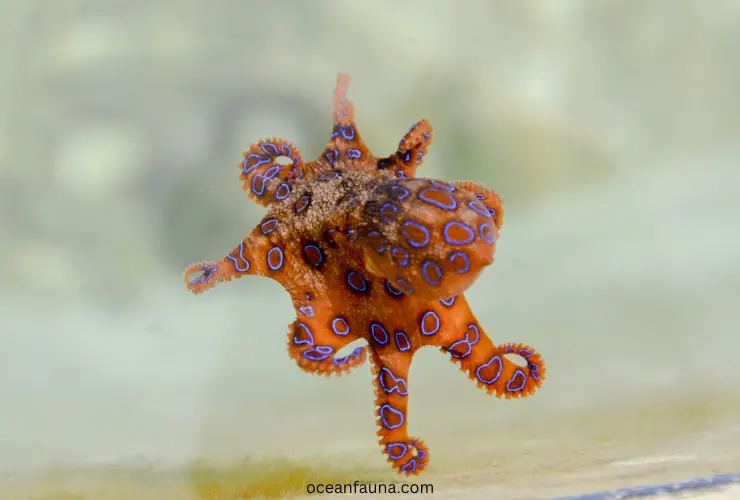Meet the blue ringed octopus. It is a highly venomous species found in the Pacific and Indian oceans. Their distinctive yellow skin is marked with blue and black rings. These rings change color when the octopus feels threatened. They inhabit tide pools and coral reefs from Japan to Australia.
The blue ringed octopuses belong to the genus Hapalochlaena. They are a highly venomous species of octopuses. There are four species in total (blue ringed octopus). Despite their small size, they are considered one of the most dangerous creatures in the ocean.
Have you ever heard of the blue ringed octopus? Do you know why it is considered one of the most dangerous creatures in the ocean? If you’re intrigued to learn more, then keep reading to discover fascinating facts about this venomous but interesting species. You’ll love to discover more facts about it.
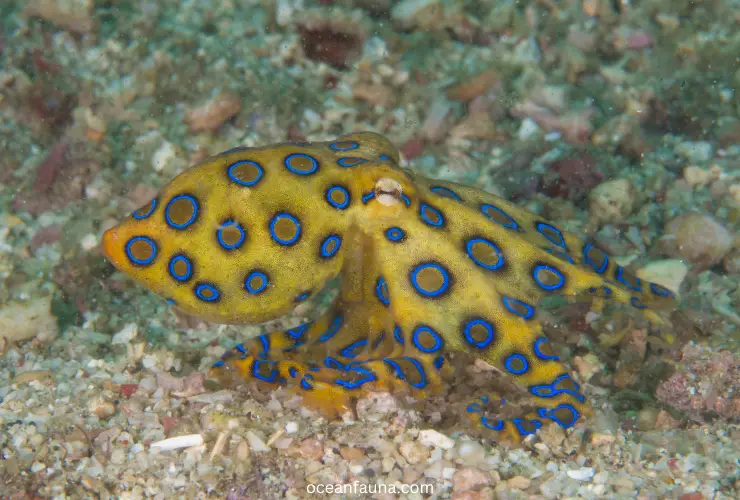
About Blue Ringed Octopus: A Quick Biology
Before diving deep into the fascinating facts about this marine beast, let’s take a quick look at its quick biology. Read the table below to learn more.
| Parameters | Details |
| Type Species | Hapalochlaena lunulata (Quoy & Gaimard, 1832) |
| Kingdom | Animalia |
| Family | Octopodidae |
| Genus | Hapalochlaena (Robson, 1929) |
| Phylum | Mollusca |
| Class | Cephalopoda |
| Order | Octopoda |
| Species | H. fasciata (Hoyle, 1886)H. lunulata (Quoy & Gaimard, 1832)H. maculosa Hoyle, 1883H. nierstraszi (?) Adam, 1938 |
| Habitat | Depths from intertidal flats down to 50m. |
| Life Span | About 2 years |
| Diet | Small crabs, hermit crabs, shrimp, and occasionally small fishes |
| Geography | Sea of Japan, Southern Australia, Philippines, Vanuatu. |
| Weight | 28 grams |
| Length | Bodies of 5 cm long and arms 10 cm. |
| Synonyms | The lesser blue ringed octopus: Hapalochlaena maculosa, the greater blue ringed octopus: Hapalochlaena lununata |
Classification of Blue Ringed Octopus
A study has described the classification of blue ringed octopus in the following words:
The genus Hapalochlaena was first discovered and stated by a British zoologist named Guy Coburn Robson. It was described in 1929. There are four main species of this genus. Additionally, six main species are being researched but remain undescribed. The four confirmed species are:
- The first species is called the greater blue ringed octopus. Its scientific name is Hapalochlaena lunulata.
- The second species is called the southern blue ringed octopus. It is also known as the lesser blue ringed octopus. Its scientific name is Hapalochlaena maculosa.
- The third species is known as blue lined octopus. Its scientific name is called Hapalochlaena Fasciata.
- The fourth species is known as apalochlaena nierstraszi. This species was first documented in the year of 1938. It was observed from a single specimen. And guess what? This specimen was found in the Bay of Bengal.
Thus, the genus Hapalochlaena contains four confirmed species, with ongoing research indicating the possibility of six more species.
Difference between species
Peter Morse, a marine zoologist at James Cook University in North Queensland, Australia, is an expert in studying octopuses, especially noticed their mating habits. He highlights a key dissimilarity between the two types of blue ringed octopus, which is their method of reproduction.
According to Morse, the way these octopuses reproduce sets them apart. They have distinct mating habits that vary between the four species of blue ringed octopus. He also believed that there are only two subspecies of blue ringed octopus. (Source)
Appearance of Blue Ringed Octopus
Blue ringed octopuses have the following physical characteristics described by Bronwyn Allan in his article on Aim’s site: (source)
- These octopuses are small in size, typically around 5-8 cm.
- Their body is soft and plump, with a bulbous head and eight tentacles.
- The octopus has light brown or yellow skin with iridescent blue rings.
- The number of rings can vary between species, but they usually have 10-50 rings.
- The blue rings appear as small, vibrant circles that pulse and shimmer when the octopus is threatened or agitated.
- The blue coloration of the rings is caused by specialized pigment cells called chromatophores.
- This octopus is often described as one of the most beautiful creatures of the sea due to its striking coloration.
Thus, the blue ringed octopus is a fascinating and unique creature known for its striking appearance and colorful markings.
Diet And Nutrition of Blue Ringed Octopus
According to the study, “Blue ringed octopuses mainly feed on small crustaceans, such as shrimp and crabs, and opportunistically prey on small, injured fish. When hunting, they quickly grab their prey using their arms and pull it towards their mouth.
The octopus then uses its beak to pierce the exoskeleton of the prey like shrimp or crab. It then injects its deadly venom. The highly deadly venom targets the muscles needed for movement, ultimately causing paralysis and death of the prey.”
When it comes to feeding, these octopuses employ their venom in two ways:
- Firstly, they grab and break its preys’ shell using their beak. Then, they directly inject their venom into the open wound.
- Alternatively, they can also release a venomous cloud into the water around their prey, which the latter will unknowingly inhale through their gills.
For example, the venom of blue ringed octopuses affects crabs swiftly due to their open circulatory system. Consequently, crabs become weak and helpless. These octopuses prefer to feed on crustaceans that are either smaller or equal in size to their heads.
Reproduction And Lifespan of Blue Ringed Octopus
During the blue ringed octopus mating ritual, the male approaches the female. He then caresses her with the help of his modified arm. This arm is known as hectocotylus. The male then grabs the female, sometimes completely obstructing her vision.
He transfers sperm packets now by repeatedly inserting his hectocotylus right into the female’s mantle cavity. Mating continues here. It continues until the female octopus has had enough. The female octopus often removes the male octopus by force in many cases.
Male blue ringed octopuses have been observed attempting to copulate with other members of the species. They don’t care about of sex or size. However, such interactions between these male octopuses are usually shorter (duration) as compared to mating with females.
Female blue ringed octopuses lay only 50 eggs in their entire life. It is usually towards the end of fall. The eggs are usually incubated easily under the arms of female octopuses for approximately six months.
She does not eat anything during this time period. The female octopus will die soon after the hatching of eggs. The new babies will be mature now. They will be able to have sex by the following year.
Factors such as nutrition, temperature, and light intensity within their habitat may affect the lifespan of blue ringed octopuses. While their typical lifespan is two to three years, it may vary. However, their venomous bite remains a constant threat to humans, making it crucial to exercise caution when handling them.
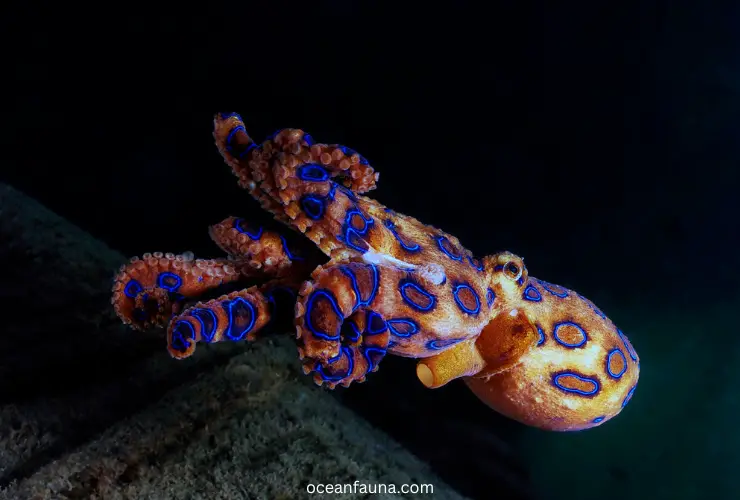
Behavior of Blue Ringed Octopus
Marine Bio organization’s authors have talked about its behavior innovatively. Let’s go through the quick ecology of this marine creature: (source)
Blue ringed octopuses hide in crevices. They can display themselves in an effective camouflage pattern with the help of their dermal chromatophore cells. They can easily change shape, allowing them to fit into small spaces. The nature to Pile up rocks outside their lairs and squeeze them into tiny crevices helps them to stay safe from predators.
When blue ringed octopuses are provoked, these species can change color quickly as a warning display. Their beautiful rings (50-60) become bright yellow and the iridescent blue within each ring flashes within a third of a second. If we take the greater blue ringed octopus, the rings have light reflectors called iridophores. These multilayer reflectors can reflect light combo of blue-green.
Darkly pigmented chromatophores are located on the rings. Unlike other cephalopods, there are no chromatophores present right above the ring. The fast flashes of blue are achieved by using muscles that are under neural control.
Each ring is usually hidden by the contraction of muscles above the iridophores. What’s the most interesting behavior of this animal? The blue ringed octopus, like other Octopoda, uses jet propulsion to swim by giving out water from a funnel.
Mating Behavior of Blue Ringed Octopus
The southern blue ringed octopus shows that body mass is the most significant factor in copulatory rates. Females exhibit a preference for larger males, while males show no preference for females. Male octopuses expend more effort in initiating copulation. They are unlikely to use odor cues to identify mating partners.
Male-male mounting attempts are common, suggesting no discrimination between sexes. Male octopuses adjust mating durations based on the female’s recent mating history. If a female has not mated with another male, it is less likely that copulation will terminate. In such cases, the mating duration is also longer.
Habitat of a Blue Ringed Octopus
We have gathered the following information from Aim’s website in Australia:
“The blue ringed octopuses are found in the Sea of Japan and southern Australia, as well as in the waters stretching from the Philippines to Vanuatu. They live in depths ranging from intertidal flats to 50m. During the day, they conceal themselves in crevices or under rocks, and come out at night.” (Source)
The Ink of a Blue Ringed Octopus
The ink of a blue ringed octopus is not commonly used for defense or camouflage like other octopus species. Instead, they use their venom as a primary defense mechanism. The ink they produce is generally considered to be a byproduct of their feeding and waste elimination processes, and not a key part of their survival strategy.
Intelligence of a Blue Ringed Octopus
Blue ringed octopuses are known for their intelligence and problem-solving skills just like other octopuses. They are capable of navigating mazes and learning from experience.
They have excellent eyesight and can recognize shapes and colors. They have been observed using tools such as coconut shells and seashells to build shelters or protect themselves.
Blue ringed octopuses are also able to change their skin color and texture. This way, they blend in with their surroundings and avoid predators. They have been shown to exhibit signs of personality and individuality.
Despite their small size, blue ringed octopuses are formidable hunters. They have a unique hunting strategy that involves using their venom to paralyze their prey.
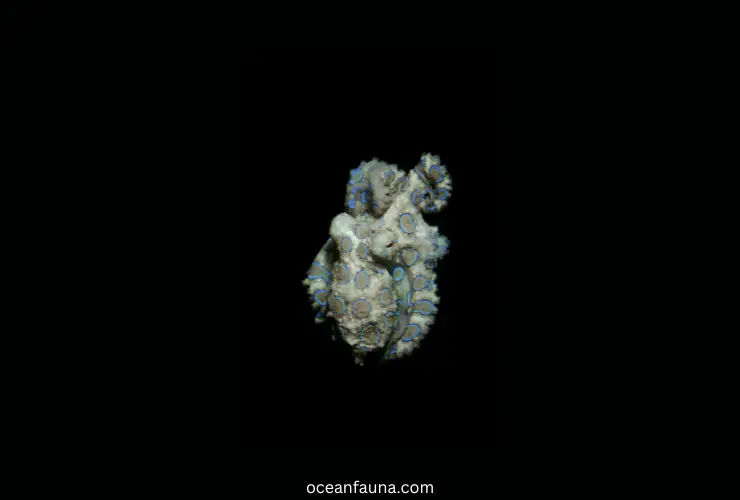
Cardiovascular And Nervous System of a Blue Ringed Octopus
The cardiovascular system of blue ringed octopus:
- These octopuses have a three-chambered heart.
- The heart is responsible for pumping oxygenated blood throughout the body.
- These octopus also have two main arteries that lead to the gills.
- The gills are responsible for extracting oxygen from the water.
The nervous system of blue ringed octopus:
- These octopuses have a complex nervous system.
- They have a centralized brain and a network of nerves throughout their body.
- They can learn and remember tasks.
- The venom produced by blue ringed octopuses affects the nervous system of their prey, causing paralysis.
The blue ringed octopus has a unique and efficient cardiovascular and nervous system. This allows it to survive in its environment and use its venom for defense and prey capture.
Predators of the Blue Ringed Octopus
Predators of the blue ringed octopus are diverse and varied, ranging from fish and cephalopods to birds and mammals. Some of the predators that feed on the blue ringed octopus include:
- Moray eels: These eels are known to have resistance to the blue ringed octopus venom.
- Triggerfish: They are not only immune to the blue ringed octopus venom but also possess strong jaws to crush the octopus.
- Crabs and shrimp: These are among the most common predators of the blue ringed octopus.
- Sea snakes: Some sea snakes have also been observed preying on blue ringed octopi.
- Birds and mammals: Certain birds, such as herons and kingfishers, and mammals like seals, are also known to eat these octopuses.
The blue ringed octopus has a range of predators that include various fish, cephalopods, and even sea snakes, which are immune to its toxic venom.
Blue Ringed Octopus in the Culture And Custom
The blue ringed octopus is a prominent symbol in the 1983 James Bond film Octopussy. In Michael Crichton’s book known as “State of Fear”. In this book, a terrorist organization uses the deadly venom of an animal as a favored weapon for murder.
Furthermore, “The Adventure Zone” includes a blue ringed octopus in its series. This series was known as “Petals to the Metal”. In January 2019, a video on TikTok of a tourist handling a blue ringed octopus in Australia went viral. In January 2023, a diner in China mistakenly served a blue ringed octopus.
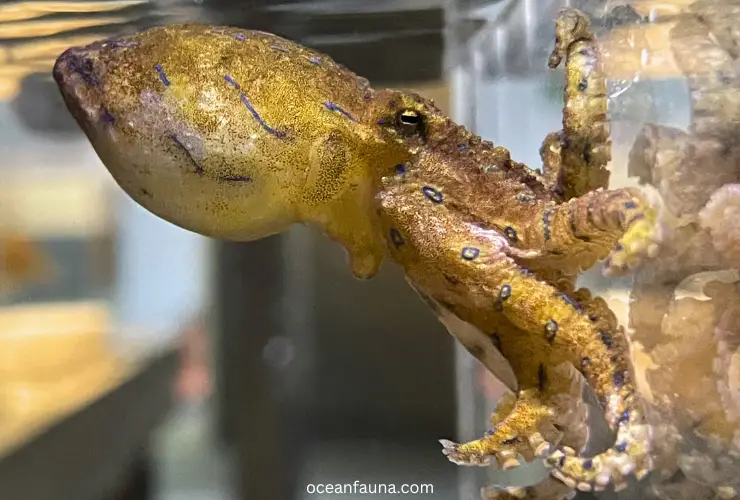
Conservation Status of Blue Ringed Octopus
The blue ringed octopus is currently categorized as Least Concern by the International Union for the Conservation of Nature (IUCN). However, the following factors could potentially affect their population:
- overfishing
- habitat degradation
- bioprospecting
- human disturbance
- collection for the aquarium trade
Despite this, Hapalochlaena may play a crucial role in marine conservation by enhancing habitat biodiversity and balancing food webs. They could also aid in controlling the population of Asian date mussels. Further study on the tetrodotoxins produced by blue ringed octopuseses could lead to new medicinal discoveries.
Oceana’s researchers have investigated the following facts about its conservation status and population:
“Blue ringed octopuses that live in shallow waters may be at risk due to coastal development and other human activities. A single specimen captured in the Bay of Bengal was used to describe one of the four species of blue ringed octopuses, and there is debate among scientists about whether it should be considered a separate species.” (Source).
What Adaptations Do the Blue Ringed Octopus Have?
Blue ringed octopuses possess several unique adaptations that allow them to survive and thrive in their environment. Here are five of them:
- Camouflage: These octopuses can change their skin color and texture to blend in with their surroundings. They can mimic objects like coral and rocks to avoid predators or sneak up on prey.
- Nocturnal Lifestyle: Blue ringed octopuses are primarily nocturnal creatures, which means they are most active during the night. This lifestyle allows them to avoid predators and take advantage of the cover of darkness to hunt for prey.
- Venomous Bite: The venom of these octopuses is incredibly potent and contains a toxin called tetrodotoxin, which can paralyze their prey or fend off predators.
- Jet Propulsion: These octopuses can use their muscular mantle to take in and expel water, allowing them to swim quickly through the ocean. This propulsion mechanism is crucial for catching prey and escaping predators.
- Small Size: These octopuses are small in size, with most species measuring less than 20 cm in length. Their small size makes them harder for predators to spot. This allows them to squeeze into tight spaces in search of food.
- Short Life Span: Blue ringed octopuses have a very short lifespan of only 1-2 years. This short life span allows them to maximize their reproductive potential. It also ensures that they don’t outlive their environment’s resources.
- Beak-like Mouth: Blue ringed octopuses have a powerful, beak-like mouth that they use to break open the hard shells of their prey. This mouth structure is unique among octopuses and is a key adaptation for their feeding habits.
- Flexible Arms: The eight arms of blue ringed octopuses are incredibly flexible and can move in any direction. This flexibility allows them to reach around objects and catch prey, even in tight spaces.
Hope you enjoy reading about these adaptations of this sea animal.
Conclusion
Blue ringed octopuses are fascinating creatures with a range of unique facts that set them apart from other sea animals. Despite their small size, blue ringed octopuses are incredibly dangerous to humans. Their venom is considered one of the most potent in the animal kingdom. As such, these creatures should be respected and observed from a safe distance.

